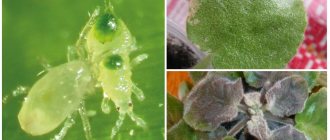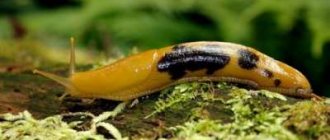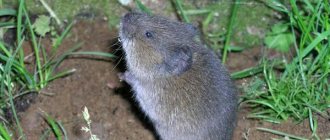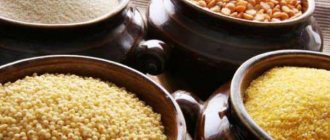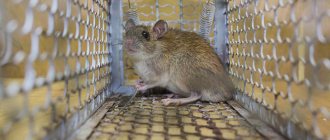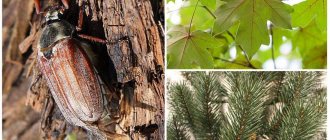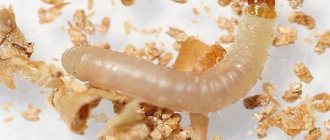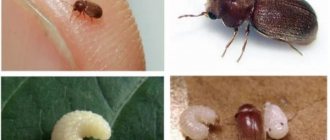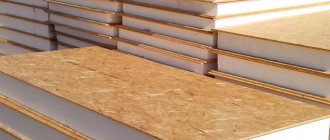What do slugs look like?
The body of the pest, consisting of a head, legs and torso with a mantle, is somewhat flattened and elongated.
On the clearly visible head, which rises when moving, there are 2 pairs of tentacles. The long ones contain the olfactory organs and eyes, and the short labial ones contain taste and touch receptors. Using the leg located in the lower part of the body, the slug crawls. The pest's skin is bare, thin and covered with characteristic mucus. The color of the integument can be varied: brown, sandy, brown, gray, in some cases there are small spots of black or white on a brown background.
Wave-like contractions of the slug's body allow it to move. To prevent the delicate skin from being damaged due to friction with the ground, the pest secretes a special mucus that prevents drying out.
It can be of different consistency - watery or sticky thick. In color it can be matte white or transparent. Thanks to it, some types of slugs are reliably protected from enemies, because it has a rather unpleasant smell and taste. The oral apparatus of the mollusk has a powerful tongue with a thousand small teeth.
who eats slugs?
White birch
Slugs have a fairly wide range of enemies, including predators. Many vertebrates feed on them, however, there are no specific “slug eaters” among them. Of the mammals, slugs are readily eaten by hedgehogs, moles, shrews and some mouse-like rodents; Birds include rooks, jackdaws, starlings and some seagulls, and poultry include chickens and ducks. Slugs are also part of the diet of many frogs, toads, salamanders, lizards and snakes. Among invertebrate insects, many insects feed on slugs. There are especially many of them among ground beetles (Carabidae). https://ru.wikipedia.org/wiki/РЎР» изень
Features of reproduction
By their nature, slugs are hermaphrodites - each individual simultaneously has both female and male sexual characteristics. However, laying eggs requires cross-fertilization, so individuals search for each other by smell.
After mating, they exchange sperm with each other, and after some time they lay 20-25 eggs in moist soil. Literally 2-3 weeks later, new slugs appear and live by feeding on the remains of organic matter. After 1.5-2 months they grow and begin to reproduce.
Adults that lay eggs in the fall die. The duration of the development cycle may vary and depends on weather conditions. In some cases, pests that did not have time to lay eggs in the fall overwinter in the ground, and after the onset of spring they begin laying eggs.
How do slugs reproduce?
™Unquenchable Star… ®
Slugs are a group of terrestrial mollusks with a partially or completely reduced shell. Slugs are active only at a certain level of soil moisture - they need water to restore mucus, which is consumed during movement and evaporation. In dry years, slugs reproduce poorly, become lethargic, and feed less. During prolonged drought, they surround themselves with a cocoon and wait out the unfavorable period. In wet years they fatten and feast in our gardens and also spread fungal diseases.
Slugs are active only at a certain level of soil moisture - they need water to restore mucus, which is consumed during movement and evaporation. In dry years, slugs reproduce poorly, become lethargic, and feed less. During prolonged drought, they surround themselves with a cocoon and wait out the unfavorable period. In wet years they fatten and feast in our gardens and also spread fungal diseases.
Many species of mollusks have a shell, but some, such as naked slugs, have an underdeveloped or completely absent shell. There are two pairs of tentacles on the slugs' head. At the end of one of them there are eyes. The mouthparts of gastropods consist of an unpaired oral jaw and a muscular tongue, the surface of which is covered with rows of small teeth called grater (radula). Using a jaw and a grater, the clams cut, scrape and grind food. This type of mouth organ is called grinding. The wide lower part of the body with which slugs move is called a leg.
Field slugs usually appear on plants in the evening and at night, and during the day they hide in cracks in the soil and in other shaded, moist places. Slugs are hermaphroditic animals, since each individual has male and female genital organs. To reproduce, slugs mate. Fertilized eggs are laid in small voids in the soil; the number of eggs varies. When meeting each other, each slug tries to bite off the other's manhood. The one who loses it... becomes a woman and a mother.
https://www.sanpros.ru/depredators/gastropods/ [link blocked by decision of the project administration] A very interesting fact - the record for length belongs to another hermaphrodite animal - the Corsican slug, whose full length penis is 60 centimeters, which is four times the length of his body. If such proportions were maintained in humans, then the length of a man’s penis would be close to 8 meters!
Olik
approximately the same as flies)) ) - cancer!
Uncle Yurik
licked off
M Grieg
sexually, like all molluscs.
HONEY...lime
I did not see. In my opinion, they are like real men; they try to do it in the dark.
Evgeniy Weber
slugs lay eggs, similar to large eggs 2=3 mm in diameter, in constantly damp places with minimal access to light
NyutiK
When they crawl, they leave behind a strip of mucus with some secretions, then the female slugs crawl along this same strip and fly in!
Oleg Volkov
Cuttings of course!!!
~VESNA-LETO~
Slugs do not have a shell, or have a remnant of it on their back in the form of a plate hidden under a fold of skin.
Traces of damage left by mollusks are very characteristic: on the leaves there are irregularly rounded holes, and on the fruits and tubers there are wide, shallow pits. In this case, they act with the radula, traces of which are visible on the damage. The field slug usually breeds all summer, laying up to 500 eggs in groups of 20-30 eggs in the ground or under moss. Young slugs hatch from the laid eggs after 2-3 weeks, which become sexually mature after 1.5 months. Thus, the reproduction rate of field slugs is high, but at the same time it depends on external conditions - temperature and humidity. Slugs die off when the temperature rises to 30°C and the humidity drops to 10-15%. Therefore, mass reproduction of slugs occurs in cool and damp summers.
Agrotechnical method of control
The mechanical method involves collecting slugs by hand or preparing traps for catching.
If you collect slugs by hand, use tweezers.
Use your knowledge of what slugs like and don't like. Prepare traps:
- They love the smell of beer and fruit. Place canvas, burlap, or cabbage leaves between the beds, pre-soaked in beer or fruit juice. During the day, slugs will fall into traps, and by evening you will simply gather “invited guests.”
- They don't like salt and soap. Dig small depressions between the rows of plants and place not very deep containers, which you fill with a strong solution of salt or soap. Cover the top with burlap or a rag. Slugs getting into the solution prepared in this way die.
- They do not like dry porous material. Scatter crushed eggshells, broken shells, or pea gravel around the plants. The rough surface is not very pleasant for slugs; they cannot reach the plants.
Phyto-method - using the smells of herbs:
- Parsley
- Bay leaf
- Santolin
- Rosemary
- Sage
- Thyme
- Lavender
The biological characteristics of slugs and their way of life are such that for normal existence they need damp, shady places where they can hide at any time. To repel pests, it is necessary to thin out and remove weeds in areas with crops.
In addition, it is necessary to remove boards, branches or stones from the areas, which provide an ideal hiding place for slugs. If they are widespread in the garden or garden, you need to remove the garden composter, which is an ideal place for pests to live and lay eggs.
We suggest you read: What is the difference between slugs and snails?
A simple and safe method of getting rid of slugs is the use of traps. The basis of these simple devices are juices, beer and dairy products - the favorite delicacies of these pests. A deep container, such as a glass, must be immersed in a pre-dug hole so that its edges are flush with the ground. The container should be filled with beer, juice or milk.
It is better to set the trap in the evening and check its contents in the morning: slugs will be attracted by the smell of the bait, but when they get into a container with liquid, they will drown. Many people use citrus fruits as bait for pests.
You can, for example, remove the pulp from a grapefruit and leave “domes” of two halves in the area with the plants being grown in the evening. The next day all that remains is to destroy the slugs that have gathered near them.
How do slugs appear? ? Are these also snails or not???
Lina's secret
SLUGS OR Slugs Slugs are gastropods with an elongated body covered with mucus. The shell is overgrown with a mantle and is completely or partially reduced. Slugs live in damp places and feed on plants. Many slugs eat mushrooms, some are found in fields and vegetable gardens, causing damage to cultivated plants. Active at night. The body of gastropods is parasitized by the larvae of various flukes. Slugs or slugs are members of two families of terrestrial pulmonate mollusks. Their body is devoid of an external shell, but under the mantle there is a rudimentary non-spiral shell in the form of a calcareous plate or, in some, several calcareous grains. Representatives of one family have jaws without ribs, while the other has highly developed ribs. Representatives of these families live in all zones of both hemispheres, live mainly in damp places and feed on both plant and animal substances. By devouring plants (vegetables, berries, etc.), some slugs can cause significant harm. Little mobile; alarmed, he pulls his head under his robe. It produces abundant viscous mucus, on the threads of which it can hang. Eggs are laid in clusters. The field slug, compared to the previous one, is very mobile, is characterized by strong reproduction and causes great damage to vegetable gardens. Like some other slugs, it can descend from branches on a slimy thread. Drown the slugs. Get a few wide-mouth jugs and fill them a third full with cheap beer. Then bury the jars around the perimeter of your garden, or whatever you intend to keep slugs out. Make sure the edges of the jug's neck are level with the ground. For some reason, slugs love beer. They will crawl to the traps, climb inside and drown. Set traps in the evening, let them party all night, and organize a funeral for them in the morning.
RIPvanWINKLE
In the summer heat, snails leave shell houses in their burrows.
PoNoChKa
The slug is the snail's cousin...
kkkk
Slugs are the same as Toko snails without a shell. And they appear from eggs. They are hermaphrodite slugs.
Why do slugs appear on the site or in the house and what harm do they cause?
When there are large numbers of slugs, they can cause serious damage to vegetation. Pests use about 150 crops as food. Among them are cabbage, tomatoes, legumes, cucumbers, potatoes, carrots, strawberries and others.
In addition to the damage that slugs cause to garden plants, they also provoke the development of infection with diseases such as downy mildew, gray rot and others. Pets can also be harmed by slugs.
Mollusks live in natural conditions and eat leaves, excrement, and mushrooms. They balance the ecological balance of animal communities in the forest and field. Sometimes they crawl onto plants that are placed in the house, for example, decorative flowers. Stalkeyes are also introduced into areas with newly acquired infected vegetation.
The increase in pests becomes massive in a suitable environment. Ideal conditions for them:
Wet, trampled earth and a pile of fallen leaves are a good place for pests to live. On a personal plot, they settle under large leaves, in the shade of bushes, and in pits with compost. Mollusks happily stay in basements and cellars, where they spoil the collected fruits and vegetables, spread mold, various infections, incl.
In the vegetable garden and in the garden, pests gnaw at crops and spoil the appearance of ornamental vegetation. The nature of the damage differs and depends on the culture and the period of its formation:
- they eat the stems of sprouted grain crops, seedlings and vegetable seedlings;
- in cabbage, beets, clover - they gnaw out uneven round holes in the foliage;
- leaves of cereal crops are eaten completely or eaten around the edges.
We suggest you read: Bat nest in nature
In greenhouses, greenhouses and greenhouses they destroy tender sprouts of seedlings, and in storage they eat potatoes. Apartments, houses and country houses are part of the territory inhabited by gastropods. The most common objects of sabotage:
- ground floor apartments;
- houses with high humidity;
- buildings with cellars;
- bathrooms - constant use of water leads to dampness, which they love so much.
You can also find a pest in the bathroom, toilet, and kitchen. This happens to residents of the private sector, as well as to people living on the first floor of an apartment building, or in an apartment with high humidity.
In summer, slugs enter people's homes in the hope of finding coolness and moisture, and in winter they crawl into warmth. They will not crawl out of the premises themselves, because they take root well and reproduce in suitable home conditions.
Varieties of slugs
Slugs prefer damp places. If the soil is dry, they die or become buried in the ground. Very often they can be found in the forest or in the garden. An excellent place for them is thickets of bushes. They can also live in the far corners of parks, where there is a body of water nearby. They feed on leaves, mushrooms, berries and flowers. Some species feed on worms. They cannot live in hot places. These mollusks are not found in deserts.
The drug Ridomil Gold - composition and instructions for use
There are many types of slugs. Many of them are pests. The most common are:
In nature, there are several hundred species of this mollusk.
How to get rid of slugs using folk remedies?
The easiest way to combat these pests is hot water. It can be used to kill slugs that have grown on cabbage. The procedure must be performed in the evening.
To do this, water is heated to a temperature of 40-45°C, and then the heads of cabbage and the ground around them are watered with it. Cabbage is not afraid of hot water, but it is very dangerous for the thin skin of slugs. You can protect plants from mollusks by spraying using:
- garlic infusion, for the preparation of which you need to pour 200-250 grams of crushed cloves with water (10 l) and leave for 24 hours, stirring from time to time;
- mustard infusion. It’s easy to prepare: you need to dissolve mustard powder (50 g) in water (300 ml) and leave for an hour. Before processing, the infusion should be diluted with water;
- tobacco infusion, which can be prepared by pouring tobacco dust (1 kg) with water (10 l) and infusing the mixture for a day. Before use, add a small amount of liquid soap;
- brilliant green solution - 1 bottle per 10 liters of water.
Watering plants and the soil underneath them can be done using:
- delphinium infusion. To prepare it, you need to pour 1 kg of crushed dry leaves with warm water (10 l) and leave for 2 days;
- mustard infusion, which is prepared by adding mustard (100 g) to water (10 l). Infusion time – 1 hour;
- hot pepper infusion. To prepare this remedy, you need to add hot peppers (1 kg of fresh pods or 0.5 dry ones) with water (10 l) and leave to infuse. After 2-3 days, the product must be boiled and infused again for 2 days;
- instant coffee (2 tsp per 200 ml of water);
- ammonia (4 tablespoons per 10 liters of water).
It is worth noting that given the high prevalence of pests on the site, all of the above folk remedies for slugs are ineffective.
Natural enemies of slugs
frogs
All frogs are very useful animals. They feed on slugs, Colorado potato beetles, and other pests. The most valuable creature for a gardener is the ground frog. Every evening it is buried in the ground to a depth of 20 cm, and dug up every morning. And when frost or drought threatens - up to 2 m. In this way, it loosens the soil, enriches it with secretions from its skin, which are initially bactericidal, and after 7-8 hours, on the contrary, accelerate the development of bacteria that destroy pollution and organic residues. In addition, this frog has a reserve supply of water, which prevents its skin from drying out. Each time, she leaves this water, which is stored in a special reservoir under the skin, in the soil, moisturizing it.
Frogs need shelters - houses that can be purchased or made. These could be holes under stones, piles of brushwood, or a buried clay pot. Although ground frogs do not need water, they winter in reservoirs with a large wintering hole, at least 2 meters. Also, this body of water should have a shallow zone where tadpoles would hide from predators. Reservoirs can be very small, but the main thing is that they are deep enough, do not freeze to the bottom, have aquatic plants on the surface and, of course, are not contaminated with pesticides.
Chemical protection against slugs
If pest control does not bring the expected results, more radical methods will be needed. How to kill a slug with chemicals, and which of them are the most effective? Most often used in such cases:
- Metaldehyde (5%) – available in the form of granules. To treat an area of 1 square meter. it will take 3-4 g. The procedure is carried out 1-2 times throughout the entire season, no later than 30 days before harvest. Pests find granules scattered throughout the area, eat them, and then die.
- In dry weather, you can use crushed superphosphate, copper or iron sulfate, or potassium salt. It will take two treatments with a break of 50-55 minutes.
- When using the drugs “Thunderstorm” and “Meta”, the maximum effect can only be achieved if the products come into direct contact with the pests.
- Preparations based on iron phosphate belong to a new generation of chemicals, since the death of pests occurs without a threat to the environment.
- Drugs such as activated creolin, dimethyl phthalate, dibutyl phthalate, and thiram have a deterrent effect.
We invite you to familiarize yourself with: Garden cranberries - cultivation, planting and care, photos
Where do slugs come from in the garden and how to get rid of them?
Slugs are a serious problem that many summer residents have to deal with. Because of these pests, you can lose a rich harvest, so you should never neglect the fight against them. From the material in this article we will learn where slugs appear in the garden, and we will also figure out how to deal with them.
Preventive measures
To prevent slugs from appearing in your home, it is important to know how to protect young and weak plants from pest attacks. One of the most important conditions is to keep the site clean and tidy.
The absence of weeds will allow for good ventilation and warming of the soil and will eliminate the appearance of cool and damp places that slugs love. You need to constantly ensure that fallen leaves do not accumulate in the garden, as moisture collects in them.
A very good way to prevent slugs and snails from entering your garden is to mulch your garden beds. Mulch can be small sawdust, which slugs avoid, because they stick to the mucus on the body, causing helplessness in the pests. Wood ash or sand scattered as mulch can cause a similar effect.
Most preventive measures are very simple and do not require money or a lot of time. Therefore, it is better to use them against slugs in advance. And then you won’t have to use chemicals that, while fighting pests, deteriorate the quality of the soil.
Tags: eat, nature, slug
About the author: admin4ik
« Previous entry
How to deal with slugs?
The fight against these uninvited guests involves the use of chemicals or traditional methods. You can try to collect them manually. But with a large concentration of slugs, this method is difficult.
Natural enemies
In nature, quite a few animals feed on mollusks. These are mainly birds: starlings, blackbirds, magpies, crows, and also rooks. You can attract winged helpers by building birdhouses on your property.
Shrews, hedgehogs, moles, and frogs also eat slugs. Attracting natural enemies is a good control measure in the absence of a large pest infestation.
Planting
By planting plants with a strong aroma in the garden, you can forget about the problem of slugs and snails. These pests do not tolerate some crops, so they will never appear in the area where they grow.
These plants include:
- Rosemary is officinalis. This seasoning perfectly repels a variety of garden pests. The leaves of the plant exude a bright and clean aroma that slugs cannot tolerate. They can be grown in open ground or pots; in the summer they are taken out into the garden and placed next to the beds where snails have been spotted.
- Parsley. It has a bright and rich aroma, as the leaves and other parts of the plant contain essential oils. Parsley effectively repels shellfish, so it is recommended to plant it next to crops that are subject to pest attacks.
- Thyme. The culture is one of the aromatic oil plants. Thyme is almost never attacked by pests, providing protection to neighboring plantings.
- Sage. This is an essential oil crop containing unique odorous biologically active substances. Thanks to its distinct spicy scent, sage repels slugs from garden beds.
- Basil. It has a pleasant aroma for humans, but slugs cannot tolerate this smell. The plant contains essential oils in the aerial parts.
- Lavender. The aroma of this plant is unpleasant and a strong irritant to slugs. It is enough to plant lavender in the garden and neighboring crops will not be attacked by pests.
- Yarrow. Due to the content of essential oils, the culture emits an aroma that is unpleasant for snails and slugs. Therefore, yarrow is, in most cases, grown as a repellent plant.
Remedy to kill slugs
The drug "Thunderstorm" is a remedy against slugs. Metaldehyde granules are good against slugs. Slugs crawl to the place where you poured this drug. After two hours, the slug that ingested the pellets will no longer be there. The drug should simply be sprinkled on the soil in a certain place and covered with something so that slugs have access to this place. This could be a cake box without a lid or something similar. Just place the box on two sticks or a board or two bricks so that there is a passage for the slugs.
